Microlearning: Ravioli with Sheep's Milk Ricotta and Lemon Zest
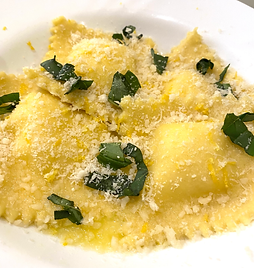
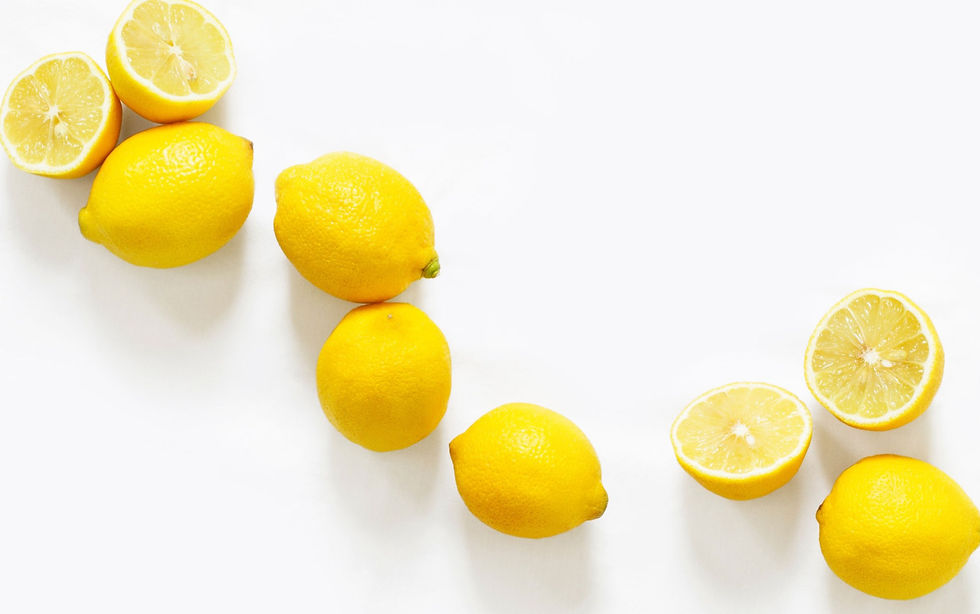
The process to select my microlearning project was a bit lengthy. I really have so many things I love to do and many others that I plan to do one day. The brainstorming list I created ranged from learning to create an online business to learning how to do french braids for my daughter to learning how to create a range of culinary dishes and food products. I eventually settled on the one that had been lingering in my mind for the longest amount of time--how to make raviolis. I also selected a certain type of raviolis, one that I had heard of several years ago and had always wanted to try--raviolis with ricotta di pecora e limone, with sheep's milk ricotta and lemon zest.
My goal was to discover adjustments that I need to make in the recipe or process in order to improve for the next time I make it. As with most dishes, they usually do not come out perfect the first time, so I expected to learn from my mistakes. To this end, I decided to build in a formative assessment or "taste test control" by pausing to cook and try the first couple of raviolis I make before I move on to make the rest of the batch. After research and gathering all the ingredients, the process of making raviolis with ricotta di pecora and lemon zest took about two and a half hours.
Introduction
Thought Process
To assess my resources, I needed to clarify my tasks and my values around cooking. Given the abundant renditions, shapes, fillings, and sauces used to make a ravioli dish, I created a criterion to guide my choices in the types of ingredients I chose to include, a criterion that reflected my culinary values. To this end, I decided to center my ravioli dish around the idea that food should be:
-
Simple (made with very few but choice ingredients)
-
Fresh (that ingredients should be local when possible and promptly used)
In terms of my tasks, I realized that I needed to focus on three separate tasks in the process of making raviolis:
-
Making the pasta
-
Making the filling
-
Putting it together
Below is a description of each process.
Making the Pasta



I’ve made pasta before so I had some familiarity with this. I’ve made it with semolina flour (hard durum) as well as by using “00” or All Purpose flour (soft durum). Typically, dried pasta is made with semolina flour and water while fresh pasta is made with “00” or All Purpose flour and eggs. Raviolis are a fresh pasta, but since it is also a stuffed pasta and soft durum wheat is generally delicate, it can easily tear when stuffed. Therefore, I have discovered that some recipes include a mix of hard and soft durum when making fresh pasta sheets for raviolis or any pasta ripiena (filled pasta). I have also found that many recipes will use semola rimacinata or “reground semolina” flour, which is a finer grade of semolina flour. I decided to use a mix of "00" flour and reground semolina flour, with the hope that the added semolina will safeguard the raviolis from tearing when they are immersed in boiling water to cook while also preserving the delicate consistency that characterizes fresh homemade pasta. Aside from this flour mixture, I decided to remain true to the value of simplicity by only including eggs as the one other ingredient. Some recipes call for added salt or water or even oil, but I don't think any of these are necessary, especially given that the pasta will be salted when it cooks. To this end, the fresh pasta ingredients are:
-
1 cup "00" flour
-
1 cup reground semolina flour
-
3 large eggs
The process is simple. Mix the flour and gather it in a heap; make a hole in the middle and crack the eggs in it (see image on left); then slowly work the flour and egg mixture together until it forms the dough. Kneed the dough for about ten minutes, wrap it in saran wrap, and let it sit for 30 minutes. During this time, prepare the filling.
Making the Filling
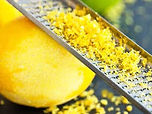

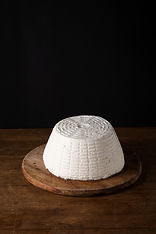

Just as I did with making fresh pasta, I researched several recipes and looked for a common theme among them to choose only the essential and choice ingredients. The two main ingredients for the filling are in the name: ricotta di pecora and lemon. The recipes that I came across also added other ingredients, usually a type of herb, such as basil, parsley, or mint, but I also encountered recipes that added cinnamon and walnuts, and some of them included salt and pepper while others did not. One common ingredient was a grated hard cheese such as pecorino or parmigiano reggiano. These are the three simple ingredients I decided on for the filling:
-
1 cup Sheep's milk ricotta
-
zest of one lemon
-
1/3 cup grated parmigiano reggiano
To create the filling, I first drained any excess water from the ricotta and then passed it through a food mill. Most of the recipes I encountered mentioned draining the ricotta, but only one suggested to pass it through a food mill. I thought it was a nice touch and give the ricotta an extra smooth and silky texture, so I decided to incorporate this into my process. Next, I grated the zest of one lemon onto the ricotta (see image on left) and mixed it in with the ricotta. Finally, I folded in the grated parmagiano reggiano cheese.
Putting it Together

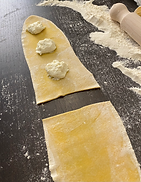
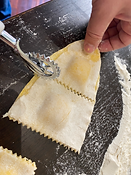
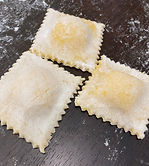


To put it all together, I simply rolled out the pasta dough, adding some extra flour to prevent it from sticking. One thing I knew I needed to pay attention to was the consistency of the dough; I needed to roll it out thin but not too thin so as to prevent a tear. Once I did this, I used a teaspoon to place small mounds of the ricotta mixture on one side of the dough. I then brushed a small amount of water on both sides of the dough and placed one on top of the other (see image on left). I carefully sealed the dough with my fingers, working out any air and molding the dough tight around the ricotta filling. I then used a cutter to shape the raviolis into separate squares.
It is at this point that I performed my formative assessment, which simply consisted of cooking and trying the initial raviolis I made to see if I needed to adjust before I proceed. The water was salted perfectly, the filling was excellent, but the pasta was a little too firm for my liking. I then proceeded to make the rest of the raviolis, paying special attention to roll the dough out thinner than I had before.
As with any pasta, I cooked the raviolis in an abundant amount of well-salted boiling water. There are a variety of sauces that you can use to dress the raviolis but for cheese and fish raviolis, the sauces are very simple (only the meat raviolis will use a heavy tomato sauce). My recommendation is to dress the raviolis in either a bit of olive oil or melted butter, add some lemon zest and basil, and serve with some grated parmigiano reggiano cheese (as in the image on the left). While some of the recipes I encountered used other ingredients, they all were very simple so as to compliment the ravioli and not change or become the center flavor of the dish.

I think the most challenging part of microlearning is actually thinking of a topic that is an appropriate scope. I had to think deeply about what it takes to learn about a given subject and how to break it down into steps. Even when I picked what I thought was an appropriate focus for the assignment, I found myself second-guessing it when I realized how much goes into what appeared to be a simpler task to begin with.
Going through the process of both developing the learning plan and then monitoring my learning process as I brought myself through it was a trying task. It was a bit messy and not a linear process. One key aspect of my plan that I liked was choosing values to guide my process. I wanted the ingredients to stand for themselves as opposed to mixing in other ingredients that could mask the taste of the ingredients that mattered. This is why I centered my choices around "simple" and "fresh." I believe that I stayed true to this in my process, even buying the ricotta the day of so that it was the freshest possible. The one area that I could improve on is making the fresh pasta. And, when I think about it, this is the one area where I did not stay true to my value of food being made with"simple" or very few ingredients. In retrospect, the next time I make raviolis, I will likely only use "00" flour instead of mixing it with semolina flour. While I did realize the raviolis were a bit too firm when I conducted the"taste testing" control, even when I adjusted to roll the dough out thinner and moved on to make the rest of the raviolis, they were still a bit firm in the end. This made me realize that it was most likely the added semolina flour.
If I were to teach this lesson to others, I would likely incorporate demonstration videos to help learners through the process. While I would also create a straight forward recipe, I think it would be necessary to note alternative ingredients that may be more accessible to some. In addition, I would also integrate a bit of background or provide some resources on the on the differences of how raviolis are made in the various regions of Italy.
Overall, I am glad to be introduced to microlearning. I think designing lessons that focus in on short but challenging tasks can be an effective pedagogical approach to teaching, and I think it could be very valuable in online and mobile learning environments in particular.
Reflection
References
Becchi, M. (2020, May 10). Ricette e storia dei ravioli italiani, dagli agnolotti piemontesi ai culurgionis sardi. Gambero Rosso. Retrieved
Oct. 6, 2022 from https://www.gamberorosso.it/notizie/storie/ricette-e-storia-dei-ravioli-italiani-dagli-agnolotti-piemontesi-ai-culurgionis-sardi/.
Cesare, L. (2019, November 7). Ricette e storia dei ravioli italiani, dagli agnolotti piemontesi ai culurgionis sardi. Gambero Rosso,
retrieved Oct. 7, 2022 from https://www.gamberorosso.it/notizie/tortelli-di-enula-ricetta-storia-origini/.
Qual è la differenza tra semola e farina? (2020). Galbani. Retrieved Oct. 8, 2022, https://www.galbani.it/abcucina/lo-sapevi-che/tipi-di-
farina/differenza-tra-semola-e-farina.
Ravioli, da nord al sud un ripieno diverso. (2020). Passione Pasta. Retrieved Oct. 7 2022 from https://passione-pasta.it/ravioli-da-nord-a-
sud-un-ripieno-diverso/?cn-reloaded=1.
Ricotta cheese: A creamy Italian classic (2022). DeLallo. Retrieved Oct. 5, 2022 from https://www.delallo.com/blog/ricotta-cheese-a-
Ricotta Romana DOP. (2020). QualiGeo | Fondazione Qualivita. Retrieved Oct. 4, 2022 from https://www.qualigeo.eu/prodotto-
Zordan, A. (2018, December 12). Fare la pasta fresca a casa coi consigli di Gambero Rosso Academy. Gambero Rosso. Retrieved Oct. 22,